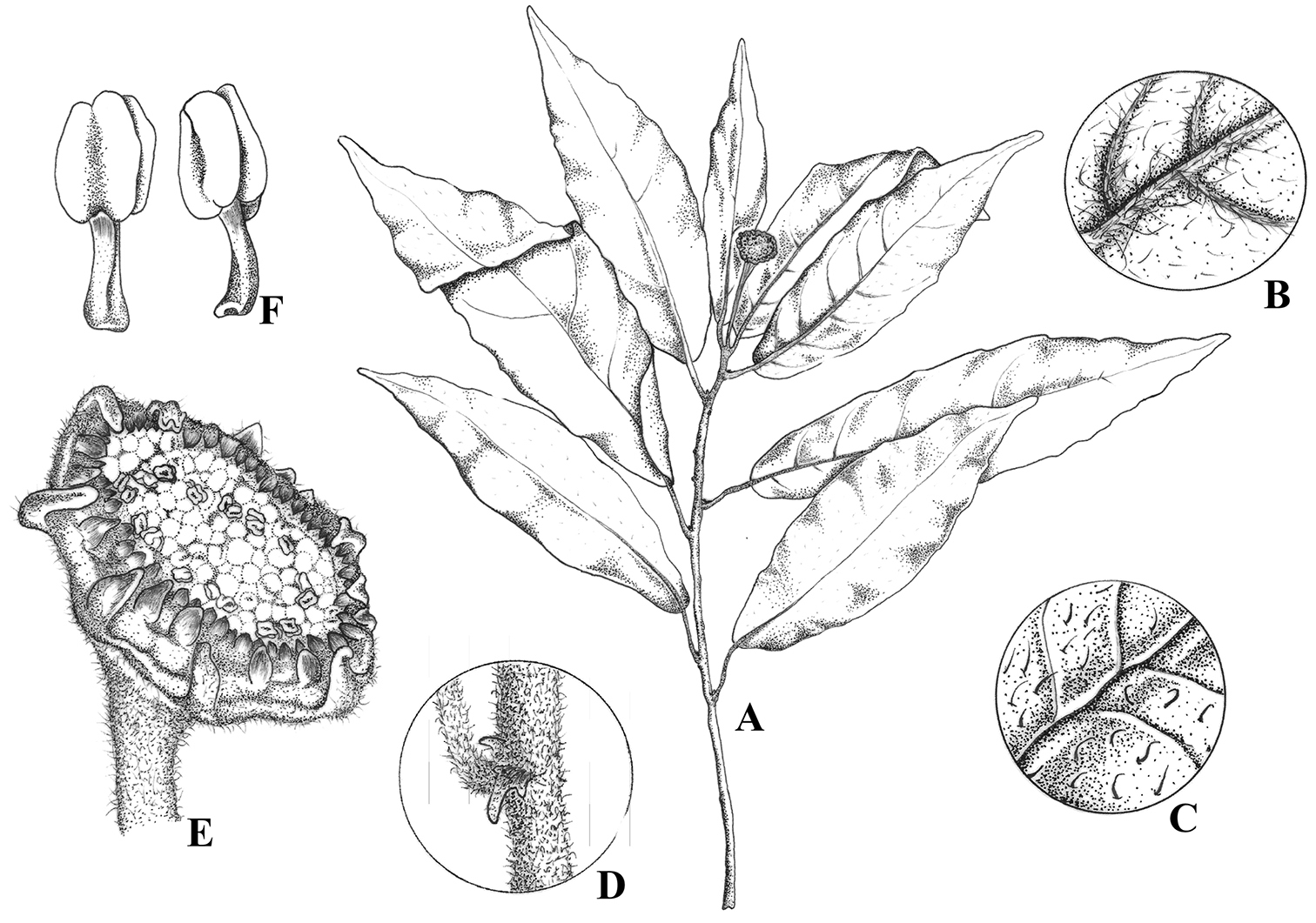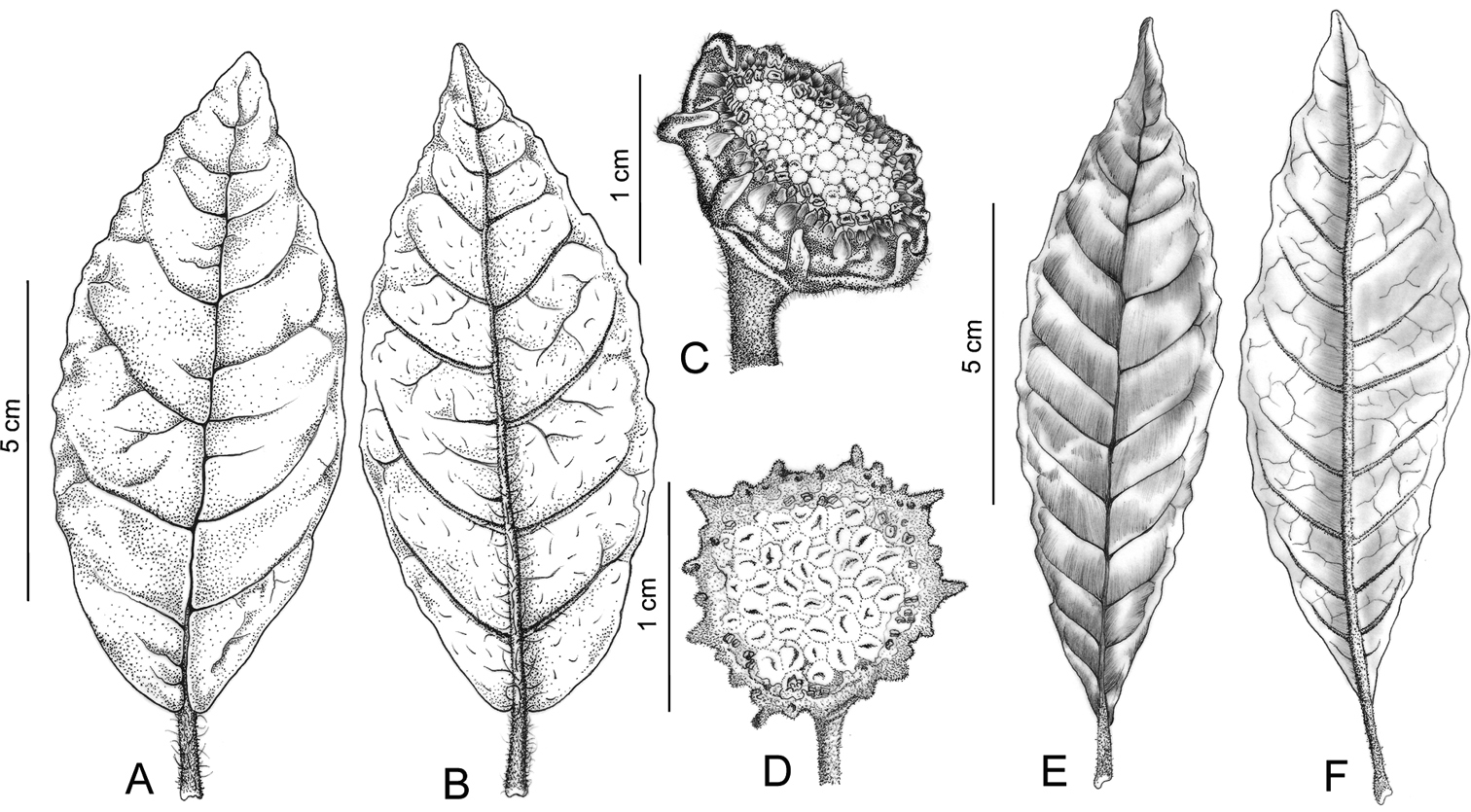






Citation: Machado AFP, Pereira JF, Carauta JPP (2014) Dorstenia triseriata (Moraceae) a new and endangered species from Brazil. PhytoKeys 38: 31–35. doi: 10.3897/phytokeys.38.7086
A new species of Moraceae is described, illustrated and compared to its close morphological relatives. Dorstenia triseriata presents similarities with Dorstenia turnerifolia but distinguished by size of peduncle, diameter of receptacle, number of bract rows, color of marginal bracts, and by an indistinct fringe on inflorescence. A conservation assessment based on IUCN criteria determines the new species to be vulnerable (VU).
Atlantic rainforest, Dorsteniae, neotropics, taxonomy
Dorstenia L. currently includes approximately 105 species and is the second largest genus of Moraceae (
Dorstenia sect. Lecania Fisher & Meyer comprises approximately 24 species, which are endemic to the rainforests of eastern Brazil. The species of section Lecania are characterized by herbaceous to suffrutescent plants usually with unbranched stems, long internodes, broad to subulate stipules, and inflorescences mostly orbicular to elliptical in shape (
Brazil. Espírito Santo: Município de Santa Teresa, Parque Natural Municipal São Lourenço, 19°56'09"S, 40°36'00"W. 28 oct 2008. TT Carrijo 1508 & AFP Machado (holotype: R!) Fig. 1A–F; 2A–C.
Dorstenia triseriata. A Habit B Leaf abaxial detail C Leaf adaxial detail D stipule E Inflorescence receptacule F Stamens (based on Carrijo & Machado 1508, Holotype).
Dorstenia triseriata. A leaf adaxial surface B leaf abaxial surface C Inflorescence lateral view. Dorstenia turnerifolia D Inflorescence E leaf adaxial surface F leaf abaxial surface. (A–C based on Carrijo & Machado 1508; D–F based on A.F.P. Machado 1081, HUEFS).
Dorsteniae turnerifoliae similis, sed pedunculo elongato (in vicem brevi), receptaculo rotundato cum una serie bracteis submarginalibus viridibus etiam duabus seriebus bracteis marginalibus violaceis (nec tantum una serie bracteis) et fimbria non distincta (in vicem fimbria distincta) differt.
Herb to subshrub up to 40 cm tall; rhizome short; stem 3–5 mm thick, hirtellous with straight and uncinate hairs, internodes up to 1(-2.0) cm long. Leaves spiraled, lamina oblong to lanceolate, or subovate to subobovate, 3–7(-9) × 1.5(-2.5) cm long, chartaceous, apex acute, base rounded, margin dentate; indumentum rough on both surfaces, of uncinate hairs, plus simple and elongated hairs on veins, lateral veins 5–8 pairs, prominent on the abaxial surface, tertiary venation reticulate; petiole 1–2 cm long, pilose; stipules persistent, subulate, 1–2 mm long, coriaceous, deflexed. Inflorescences greenish, margin purplish; peduncle 1.0–3.5 cm long, pubescent with simple and elongated hairs; receptacle circular, 0.3–0.8 cm in diameter, margin dentate, fringe not distinct; submarginal bracts green in 1 row, ovate, up to 0.5 mm long; marginal bracts purplish in 2 rows; staminate flowers at the periphery of inflorescence, tepals 3, stamens 2, filaments as long as the perianth; pistillate flowers sessile, tepals 2–3, ovary free, stigmas 2 subequal in length; fruit a dehiscent drupe rough, 2 mm.
The specific epithet is an allusion to number of marginal bracts rows, arranged in three vertical rows.
Dorstenia triseriata inhabits the states of Espírito Santo, Bahia, and Minas Gerais in Brazil.
Dorstenia triseriata is closely related to two other species: Dorstenia romaniucii A.F.P.Machado & M.D.M. Vianna and Dorstenia turnerifolia Fisch. & C.A. Mey. From Dorstenia romaniucii both other species are differentiated by the staminate flowers disposed peripherally at the inflorescence. Dorstenia triseriata is distinguished from Dorstenia turnerifolia by its elongated peduncle (vs. short), purplish and circular receptacles (vs. green and angular receptacles), fringe not distinct (vs. fringe distinct) and marginal bracts in three rows 1 green and 2 purplish (vs. 1 row). submarginal bracts green in 1 row, ovate, up to 0.5 mm long; marginal bracts purplish in 2 rows
The circumscription of Dorstenia turnerifolia adopted by
Comparative morphology of Dorstenia triseriata and its related species.
| Characters | Leaf blade (cm long) | Lateral veins | Peduncle (cm) | Receptacle | Marginal bracts (rows) | Fringe |
|---|---|---|---|---|---|---|
| Taxa | ||||||
| Dorstenia triseriata | 3–7(–9) | 5–8 pairs | 1.5–3.0 | Rounded (0.3–0.8) | 3 (1 green + 2 purple) | Not distinct |
| Dorstenia romaniucii | 2–13(–17) | 14–16 pairs | 1–1.5 | slightly angular (1–1.3) | 2 (green) | Not distinct |
| Dorstenia turnerifolia | 5–7(–17) | (7–)10–17 pairs | 0.5–1.0 | Orbicular to rounded (1–2) | 1 (green) | Distinct |
In Dorstenia the vegetative characters can be very variables specially when observed in a herbarium material. However, the reproductive characters are most reliable. The new species belongs to a group of species with similar habit and similar vegetative structures. The specimens of this group are commonly identified at herbaria as Dorstenia turnerifolia. Despite this they can easily separated with a criterious analysis of reproductive structures. The main differences between these taxa are also showed in Fig. 2 and Table 1.
According to
| 1 | Receptacle slightly angular with two rows of marginal bracts. Staminate flowers intermixed with pistillate flowers | Dorstenia romaniucii |
| – | Receptacle rounded or orbicular. Marginal bracts in 1 or 3 rows. Staminate flowers grouped peripherally at the inflorescence | 2 |
| 2 | Peduncle 0.5–1 cm, receptacle 1–2 cm diam. Marginal bracts green disposed in one row. Fringe distinct | Dorstenia turnerifolia |
| – | Peduncle 1–3.5 cm, receptacle 0.3–0.8 cm diam. Marginal bracts disposed in three rows (1 green + 2 purplish). Fringe not distinct | Dorstenia triseriata sp. nov. |
Brazil. Espírito Santo. Santa Teresa, 28 May 2008, Machado 937 (R); l.c., Santa Teresa, Parque Natural Municipal São Lourenço, 29 Mar. 2007, Monteiro et al. 368 (R); l.c., Santa Teresa, Parque Natural Municipal São Lourenço, Machado 936, l.c., Santa Teresa, Carrijo, 1507. May 2008 (R). Bahia. Itanhaém, 17°8'17"S, 40°25'34"W. 29 Dec 2004, Amorim et al., 4629 (HUEFS). Minas Gerais. Itabira, Fazenda do Quilombo, 19°37'10"S, 43°13'36"W. 27 Jan. 1943, Magalhães s.n. (HUEFS 118735)
The authors are very grateful to Juliana G. Freitas (UEFS) for the line drawings, Michella Del Rey for the assistance with the images, Marcelo Vianna Filho (JBRJ) for his comments about Dorstenia, Josiene Rossini for help at the herbarium MBML. JFP is supported by PQ-2 and PQ-1 grants from CNPq. This work is part of the M.Sc. thesis of the first author. We acknowledge CAPES for financial support for this research. AFPM is also supported by FAPESB.

